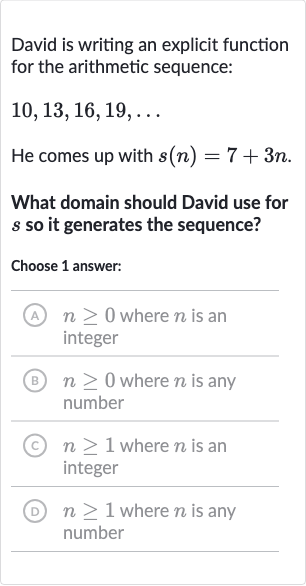AI tutor
Welcome to Bytelearn!
Let’s check out your problem:

David is writing an explicit function for the arithmetic sequence:He comes up with .What domain should David use for so it generates the sequence?Choose answer:(A) where is an integer(B) where is any number(C) where is an integer(D) where is any number
Full solution
Q. David is writing an explicit function for the arithmetic sequence:He comes up with .What domain should David use for so it generates the sequence?Choose answer:(A) where is an integer(B) where is any number(C) where is an integer(D) where is any number
- Step : Checking first term: To determine the correct domain for the function that generates the given arithmetic sequence, we first need to check if the function correctly produces the terms of the sequence when we input the appropriate values of . The given sequence is and the function is . Let's check the first term by substituting into the function.
- Step : Checking second term: Now let's check the second term by substituting into the function.
- Step : Checking third term: Next, we check the third term by substituting into the function.
- Step : Checking fourth term: Finally, let's check the fourth term by substituting into the function.
- Step : Determining domain for : Since the function correctly produces the terms of the sequence when starts at and increases by for each subsequent term, we can conclude that the domain of should start at . Additionally, since the sequence is arithmetic and each term is determined by adding a constant difference to the previous term, should be an integer to ensure that we only generate the terms of the sequence and not any values in between.
- Step : Conclusion: Given the above reasoning, the correct domain for the function to generate the arithmetic sequence is " where is an integer". This corresponds to option .
